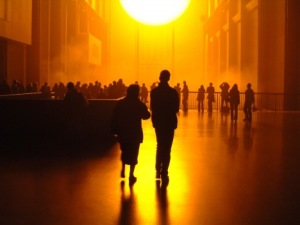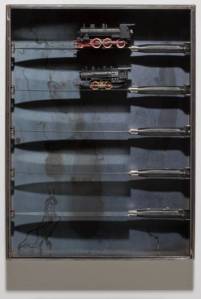Cornelia Parker is a London-based sculptor and installation artist. She was born during the year 1956 in Cheshire, England.
Cornelia Parker’s work is regarded internationally for its complex, darkly humorous, ironic style. Cornelia Parker’s work is highly allusive and patterned with cultural references to cartoons, a style which she adapts to her need to capture things in the moment before they slip away and are lost beyond human perception. When examining her entire work one can see the following themes driving her work forward consumerism, globalization, and the role of the mass media in contemporary life.
Many of Cornelia Parker’s artworks are ephemeral or ‘site-specific’, created for a single time and place. Cold Dark Matter: An Exploded View (1991) was such a work, in which Cornelia Parker had the British Army explode a garden shed, and the fragments were suspended in the air around a single source of illumination casting shadows of the shattered pieces on the walls. This work was displayed at the Tate Modern Gallery.
 ‘Cold Dark Matter: An Exploded View’
‘Cold Dark Matter: An Exploded View’
Cold Dark Matter began life as a garden shed filled with objects from her own and friends’ sheds and things bought at a car boot sale. She then asked the army to blow up the shed under very controlled conditions. The objects, along with the fragments of the shed, were collected and suspended in a closed room in an attempt to recreate the moment just after the explosion. The installation is lit with a single light-bulb at the very centre of the arrangement, casting shadows on the walls. The title gives us a whole new way of understanding the artwork, making us think of other dramatic moments of destruction and creation in the much wider universe.
– Quote from the Tate
When I first saw a photograph of this piece of artwork it made me want to go and walk through the shadows of the objects myself. I was surprised to learn that the light was just from one suspended light bulb in the centre. Using this really showcases the different shapes of the wood and objects within the explosion, and the light coming from within the structure has an intimate feel. I would like to achieve an intimate feel for my installation, so I now know I must think about how to light the piece, I do not want too harsh lighting as that would take away some of the intimacy from my piece. Cornelia Parker wants us to stop and think, to walk through her work and experience it as if we were there at the time the shed exploded. It’s a really nice piece to take inspiration from for my presentation.
The striking style of the suspended sculpture, which challenges the limitations of time and space, is typical of Cornelia Parker’s work. Hanging Fire (Suspected Arson) (1999) is another example of this type of sculpture, in which charred fragments of a building supposedly destroyed by arson are suspended by wires and pins in a pattern which is both geometrical and chaotic. The work captures the identity of the two states by a retroactive positioning, much in the manner of a forensic scientist might reconstruct the scene of a crime.
 ‘Hanging Fire ( Suspected Arson)’
‘Hanging Fire ( Suspected Arson)’
I really like how Cornelia Parker has set out her installation, once again it really takes control of the entire room it is in. I don’t want to take up the entire gallery because it is a degree show with all of my classmates, but I would like some people to want to go see my work as it will take a long time to produce. My work cannot be as neat as Cornelia Parker’s work, as I will be sewing onto it, but im hoping the homemade feel will enhance the installation.
 ‘Perpetual Canon’
‘Perpetual Canon’
This installation piece struck me as inspiration on how to suspend my ribbon and images from the ceiling of the gallery. I will be using patterned ribbon and thin fishing wire to suspend my photographs and pieces of text. I am hoping that my work can look as neat as Cornelia’s.
Some of her most noted exhibitions and works include Chomskian Abstract (2008), Never Endings (2007, 2008), Brontëan Abstracts (2006), The Distance (A Kiss with String Attached) (2003), Subconscious of a Monument (2002), Blue Shift (2001), Edge of England (1999), and The Maybe, in collaboration with Tilda Swinton (1995).















